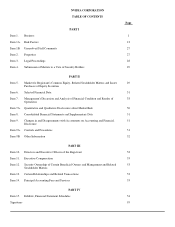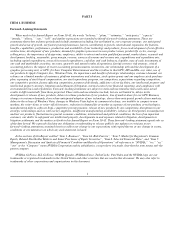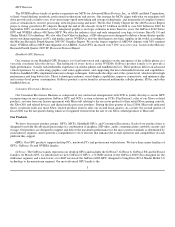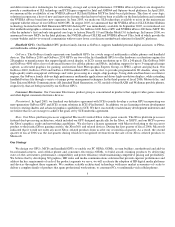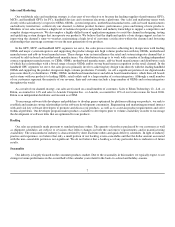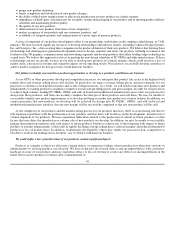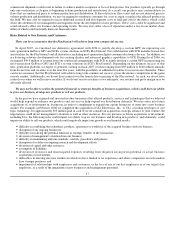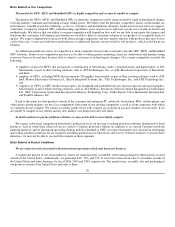NVIDIA 2006 Annual Report Download - page 16
Download and view the complete annual report
Please find page 16 of the 2006 NVIDIA annual report below. You can navigate through the pages in the report by either clicking on the pages listed below, or by using the keyword search tool below to find specific information within the annual report.
applications relate to technology used by us in connection with our products, including our digital media processors. We also rely on
international treaties and organizations and foreign laws to protect our intellectual property. We continuously assess whether and
where to seek formal protection for particular innovations and technologies based on such factors as: the commercial significance of
our operations and our competitors' operations in particular countries and regions; the location in which our products are
manufactured; our strategic technology or product directions in different countries; and the degree to which intellectual property laws
exist and are meaningfully enforced in different jurisdictions.
Our pending patent applications and any future applications may not be approved. In addition, any issued patents may not provide
us with competitive advantages or may be challenged by third parties. The enforcement of patents by others may harm our ability to
conduct our business. Others may independently develop substantially equivalent intellectual property or otherwise gain access to our
trade secrets or intellectual property. Our failure to effectively protect our intellectual property could harm our business. We have
licensed technology from third parties for incorporation in our digital media processors, and expect to continue to enter into license
agreements for future products. These licenses may result in royalty payments to third parties, the cross licensing of technology by us
or payment of other consideration. If these arrangements are not concluded on commercially reasonable terms, our business could
suffer.
Employees
As of January 29, 2006 we had 2,737 employees, 1,654 of whom were engaged in research and development and 1,083 of whom
were engaged in sales, marketing, operations and administrative positions. None of our employees are covered by collective
bargaining agreements, and we believe our relationships with our employees are good.
Financial Information by Business Segment and Geographic Data
Our Chief Executive Officer, who is considered to be our chief operating decision maker, or CODM, reviews financial
information presented on an operating segment basis for purposes of making operating decisions and assessing financial performance.
During the first quarter of fiscal 2006, we reorganized our operating segments to bring all major product groups in line with our
strategy to position ourselves as the worldwide leader in programmable graphics processor technologies. We now report financial
information for four product−line operating segments to our CODM: the GPU Business is composed of products that support desktop
PCs, notebook PCs and professional workstations; the MCP Business is composed of NVIDIA nForce products that operate as a
single−chip or chipset that can off−load system functions, such as audio processing and network communications, and perform these
operations independently from the host CPU; our Handheld GPU Business is composed of products that support handheld personal
digital assistants, cellular phones and other handheld devices; and our Consumer Electronics Business is concentrated in products that
support video game consoles and other digital consumer electronics devices and is composed of revenue from our contractual
arrangements with SCE to jointly develop a custom GPU incorporating our next−generation GeForce GPU and SCE's system
solutions in SCE's PlayStation3, revenue from sales of our Xbox−related products, revenue from our license agreement with Microsoft
relating to the successor product to their initial Xbox gaming console, the Xbox360, and related devices, and digital media processor
products. In addition to these operating segments, we have the “All Other” category that includes human resources, legal, finance,
general administration and corporate marketing expenses, which total $121.2 million and $101.5 million for fiscal 2006 and 2005,
respectively, that we do not allocate to our other operating segments. “All Other” also includes the results of operations of other
miscellaneous operating segments that are neither individually reportable, nor aggregated with another operating segment. Revenue in
the “All Other” category is primarily derived from sales of memory. All prior period amounts have been restated to reflect our new
reporting structure.
Our CODM does not review any information regarding total assets on an operating segment basis. Operating segments do not
record intersegment revenue, and, accordingly, there is none to be reported. The accounting policies for segment reporting are the
same as for NVIDIA as a whole. The information included in Note 15 of the Notes to Consolidated Financial Statements is hereby
incorporated by reference.
10


